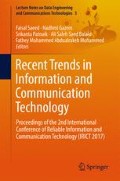Abstract
This article addresses the financial aspects surrounding the stability of the electricity sector. We apply a variety of data mining techniques to build financial distress warning models based on the financial statement analysis method. The analysis reveal that neural networks with the accuracy of 80% and above in different scenarios were found to be relatively more accurate compared to decision trees and support vector machines. Additionally, in order to assess the ability of financial indicators, we applied feature selection. The financial ratios analyses proved the significance of profitability, liquidity and financial leverage for the default prediction models. Therefore, it is exigent that companies utilize their assets, liquidity and solvency as the core of their management policy regulations. The key contribution of this paper is the formulation of a proper model for financial distress prediction among electricity sector companies in Iran.
Access this chapter
Tax calculation will be finalised at checkout
Purchases are for personal use only
References
Mirzaei, M., Bekri, M.: Energy consumption and CO2 emissions in Iran, 2025. Environ. Res. 154, 345–351 (2017)
Yu, S., Zhang, J., Fujiwara, A.: Analysis of the residential location choice and house-hold energy consumption behavior by incorporating multiple self-selection effects. Energy Policy 46, 319–334 (2012)
Yazdanpanah, M., Komendantova, N., Ardestani, R.S.: Governance of energy transition in Iran: investigating public acceptance and willingness to use renewable energy sources through socio-psychological model. Renew. Sustain. Energy Rev. 45, 565–573 (2015)
Tavanier: The details statistics of Iranian electricity industrial for electricity distribution in 2012. Ministry of Niro, Tavanier Co. (2013)
BP: BP Statistical Review of World Energy 2012 (2012)
Leon, P.: Four pillars of financial sustainability. In: Nature Conservancy (2001)
Ciby, J.: Credit Risk Analysis. Tata McGraw-Hill Publishing Company Limited, New Delhi (2007)
Altman, E.I.: Financial ratios, discriminant analysis and the prediction of corporate bankruptcy. J. Financ. 23(4), 589–609 (1968)
Altman, E.I., Marco, G., Varetto, F.: Corporate distress diagnosis: comparisons using linear discriminant analysis and neural networks (The Italian experience). J. Bank. Financ. 18(3), 505–529 (1994)
Altman, E.I.: Corporate credit scoring insolvency risk models in a benign credit and Basel II environment. New York University Working Paper, New York (2004)
Zhou, L., Lu, D., Fujita, H.: The performance of corporate financial distress prediction models with features selection guided by domain knowledge and data mining approaches. Knowl. Based Syst. 85, 52–61 (2015)
Ding, Y., Song, X., Zen, Y.: Forecasting financial condition of Chinese listed companies based on support vector machine. Expert Syst. Appl. 34(4), 81–89 (2008)
Chen, W.S., Du, Y.K.: Using neural networks and data mining techniques for the financial distress prediction model. Expert Syst. Appl. 36(2), 4075–4086 (2009)
Lin, F., Liang, D., Yeh, C.C., Huang, J.C.: Novel feature selection methods to financial distress prediction. Expert Syst. Appl. 41(5), 2472–2483 (2014)
Messier, J.R.W., Hansen, J.: Inducing rules for expert system development: an example using default and bankruptcy data. Manage. Sci. 34, 1403–1415 (1988)
Zhou, L.: Performance of corporate bankruptcy prediction models on imbalanced dataset: the effect of sampling methods. Knowl. Based Syst. 41, 16–25 (2013)
Li, H., Sun, J.: Gaussian case based reasoning for business-failure prediction with empirical data in China. Inf. Sci. 179(1–2), 89–108 (2009)
Gepp, A., Kumar, K., Bhattacharya, S.: Business failure prediction using decision trees. J. Forecast. 29(6), 536–555 (2010)
Ramakrishnan, S., Mirzaei, M., Bekri, M.: Corporate default prediction with AdaBoost and bagging classifiers. J. Teknologi (Sci. Eng.) 73(2), 45–50 (2015)
Mirzaei, M.; Ramakrishnan, S.; Bekri, M.: Corporate default prediction with industry effects: evidence from emerging markets. Int. J. Econ. Financ. Issues 6(3S), 161–169 (2016)
Chen, S., Hardle, W.K., Moro, R.A.: Modeling default risk with support vector machines. Quant. Financ. 11(1), 135–154 (2011)
McKee, T.E.: Developing a bankruptcy prediction model via rough sets theory. Intell. Syst. Account. Financ. Manage. 9(3), 159–173 (2000)
Davis, J., Goadrich, M.: The relationship between precision-recall and ROC curves. In: Proceedings of the 23rd International Conference on Machine Learning, Pittsburgh, USA, pp. 233–240 (2006)
Shie, F.S., Chen, M.Y., Liu, Y.S.: Prediction of corporate financial distress: an application of the American banking industry. Neural Comput. Appl. 21(7), 87–96 (2012)
Eriotis, N., Vasiliou, D., Neokosmidi, Z.V.: How firm characteristics affect capital structure: an empirical study. Manag. Financ. 33(5), 321–331 (2007)
Beaver, W.H.: Financial ratios as predictors of failure. J. Account. Res. 4(3), 71–111 (1966)
Libby, R.: Accounting ratios and the prediction of failure: some behavioral evidence. J. Account. Res. 13(1), 150–161 (1975)
Ohlson, J.A.: Financial ratios and the probabilistic prediction of bankruptcy. J. Account. Res. 18(1), 109–131 (1980)
Nguyen, T.D., Rainey, I., Gregoriou, A.: Financial development and the determinants of capital structure in Veitnam. Working Paper Series (2012)
Author information
Authors and Affiliations
Corresponding author
Editor information
Editors and Affiliations
Rights and permissions
Copyright information
© 2018 Springer International Publishing AG
About this paper
Cite this paper
Mirzaei, M., Hosseini, S.M.P., Gan, G.G., Sahu, P.K. (2018). Prediction of Financial Distress for Electricity Sectors Using Data Mining. In: Saeed, F., Gazem, N., Patnaik, S., Saed Balaid, A., Mohammed, F. (eds) Recent Trends in Information and Communication Technology. IRICT 2017. Lecture Notes on Data Engineering and Communications Technologies, vol 5. Springer, Cham. https://doi.org/10.1007/978-3-319-59427-9_1
Download citation
DOI: https://doi.org/10.1007/978-3-319-59427-9_1
Published:
Publisher Name: Springer, Cham
Print ISBN: 978-3-319-59426-2
Online ISBN: 978-3-319-59427-9
eBook Packages: EngineeringEngineering (R0)

